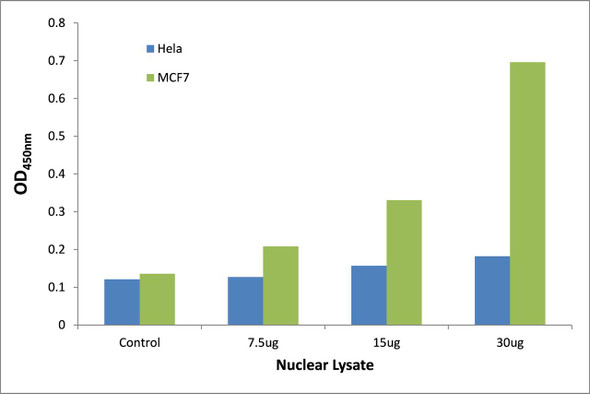Description
STAT5A Transcription Factor Activity Assay
The STAT5A Transcription Factor Activity Assay is a cutting-edge research tool designed for the precise measurement of STAT5A transcription factor activity in cell lysates. This assay offers exceptional sensitivity and specificity, guaranteeing accurate and consistent results for a variety of experimental applications.STAT5A is a key transcription factor involved in regulating gene expression and cell signaling pathways, playing a critical role in various cellular processes such as cell growth, differentiation, and immune responses.
Dysregulation of STAT5A activity has been implicated in various diseases including cancer, autoimmune disorders, and inflammatory conditions, highlighting its significance as a potential therapeutic target.With its advanced technology and reliable performance, the STAT5A Transcription Factor Activity Assay is an invaluable tool for researchers seeking to unravel the complex mechanisms underlying disease pathogenesis and identify novel treatment strategies.
| Product Name: | STAT5A Transcription Factor Activity Assay |
| Product Code: | TFAB00166 |
| Target: | STAT5A |
| Reactivity: | Human, Mouse, Rat |
| Sample Types: | Nuclear or cell lysates |
The Assay Genie STAT5A transcription factor activity assay allows for the detection and qualitative analysis of endogenous levels of activated transcription factors in a variety of nuclear and cell lysates
Assay Genie ELISA kits are designed to significantly reduce experiment time and ensure sensitivity and flexibility for high-throughput screening.
| Assay Time: | 4.5 hours |
| Detection Method: | Colorimetric 450 nm |
| Size: | 12 x 8-Well Microstrips |
| Storage: | 4°C for 6 months |
| UniProt Protein Function: | STAT5A: transcription factor of the STAT family. Phosphorylated and activated by receptor-associated kinases downstream of many cytokines and growth-factor receptors. Activation of this protein in myeloma and lymphoma associated with a TEL/JAK2 fusion protein is essential for the tumorigenesis. Induces the expression of BCL2L1/BCL-X(L) in the mouse, suggesting an antiapoptotic function of this protein. Forms homo- or heterodimers that translocate into the nucleus where they regulate transcription. Two alternatively spliced isoforms have been described. |
| UniProt Protein Details: | Protein type:DNA-binding; Transcription factor; Motility/polarity/chemotaxis; Oncoprotein Chromosomal Location of Human Ortholog: 17q11.2 Cellular Component: nucleoplasm; cytosol Molecular Function:signal transducer activity; protein binding; transcription factor activity Biological Process: lactation; succinate metabolic process; oxaloacetate metabolic process; peptidyl-tyrosine phosphorylation; positive regulation of interleukin-2 biosynthetic process; T cell differentiation in the thymus; positive regulation of multicellular organism growth; female pregnancy; positive regulation of mitotic cell cycle; fatty acid metabolic process; positive regulation of activated T cell proliferation; 2-oxoglutarate metabolic process; positive regulation of natural killer cell differentiation; sequestering of lipid; natural killer cell differentiation; allantoin metabolic process; negative regulation of mast cell apoptosis; luteinization; development of secondary male sexual characteristics; regulation of steroid metabolic process; creatinine metabolic process; T cell homeostasis; positive regulation of gamma-delta T cell differentiation; Peyer's patch development; isoleucine metabolic process; negative regulation of erythrocyte differentiation; transcription, DNA-dependent; regulation of multicellular organism growth; citrate metabolic process; valine metabolic process; development of secondary female sexual characteristics; positive regulation of natural killer cell mediated cytotoxicity; JAK-STAT cascade; creatine metabolic process; regulation of transcription from RNA polymerase II promoter; regulation of epithelial cell differentiation; positive regulation of B cell differentiation; positive regulation of transcription from RNA polymerase II promoter; taurine metabolic process; positive regulation of inflammatory response |
| NCBI Summary: | The protein encoded by this gene is a member of the STAT family of transcription factors. In response to cytokines and growth factors, STAT family members are phosphorylated by the receptor associated kinases, and then form homo- or heterodimers that translocate to the cell nucleus where they act as transcription activators. This protein is activated by, and mediates the responses of many cell ligands, such as IL2, IL3, IL7 GM-CSF, erythropoietin, thrombopoietin, and different growth hormones. Activation of this protein in myeloma and lymphoma associated with a TEL/JAK2 gene fusion is independent of cell stimulus and has been shown to be essential for tumorigenesis. The mouse counterpart of this gene is found to induce the expression of BCL2L1/BCL-X(L), which suggests the antiapoptotic function of this gene in cells. Alternatively spliced transcript variants have been found for this gene. [provided by RefSeq, Dec 2013] |
| UniProt Code: | P42229 |
| NCBI GenInfo Identifier: | 1174462 |
| NCBI Gene ID: | 6776 |
| NCBI Accession: | P42229.1 |
| UniProt Secondary Accession: | P42229,Q1KLZ6, |
| UniProt Related Accession: | P42229 |
| Molecular Weight: | |
| NCBI Full Name: | Signal transducer and activator of transcription 5A |
| NCBI Synonym Full Names: | signal transducer and activator of transcription 5A |
| NCBI Official Symbol: | STAT5A |
| NCBI Official Synonym Symbols: | MGF; STAT5 |
| NCBI Protein Information: | signal transducer and activator of transcription 5A |
| UniProt Protein Name: | Signal transducer and activator of transcription 5A |
| Protein Family: | Signal transducer and activator of transcription |
| UniProt Gene Name: | STAT5A |
| UniProt Entry Name: | STA5A_HUMAN |






